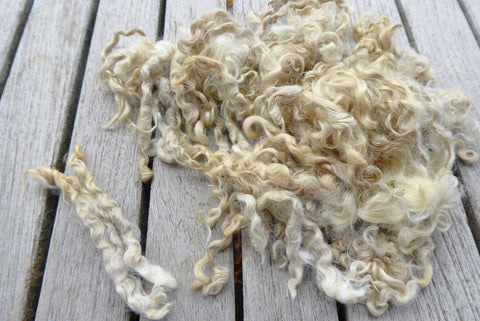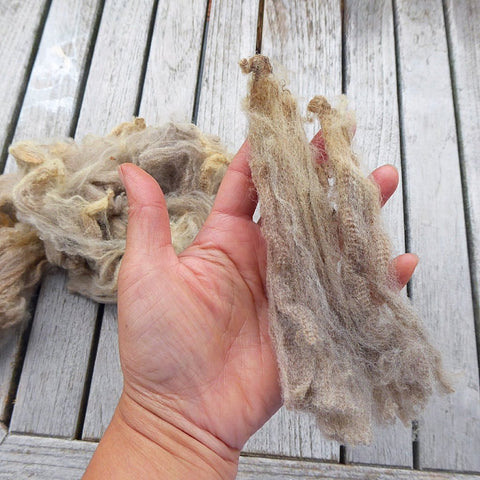
When I'm buying fleece, price is the first thing I consider, and I try to do some research before jumping into the fray. I know that the per pound price for a nice Shetland is around $25, whereas the rate for a fine fleece is more like $35 and up, and a teeswater is well over $100. I've seen mohair range from $15 (buy it all!!) - $60. These prices are just guidelines; it doesn't mean that a teeswater sheep who has been out frolicking in muck & hay and was sheared twice in one year should be anywhere near $100. I saw Shetland fleeces for $90/lb, and as much as I, as a Shetland raiser, would like to say that's the going rate, that's a price I've only seen at Rhinebeck. Of course, farms that regularly produce ribbon-winning fleeces tend to raise their prices accordingly. I'm leery about paying too much for a fine fleece, because I know that half of the weight will be lost after washing. I'll be sending these fleeces to be milled, which means that I'll be paying to ship and wash all that fleece, only to have half of the weight in useable fiber after processing.
I was smitten with a fleece that was way out of my league, and since I couldn't buy it, I took a picture of it. I think it was probably one of Kate Bostek's cormos. Absolutely dreamy, but I'd rather have it in roving form, because washing such greasy and fine cormo would send me around the bend (not to mention deplete my hot water heater).

By Sunday afternoon, most of the ribbon winning fleeces had been bought, but I was able to snag the First Place Yearling Mohair winner.

It's a lovely, silky, clean fleece, and it was reasonably priced. It was 7 lb., and I'll be dyeing it to needle felt into my Fiberarium Bonzai and Fleece Trees. It'll also be going into my art batts. The locks are a good length, and I'm eager to see what color it'll be when it's washed.
Other than price, what do I look for? Right now, I'm hunting for fleeces to blend together for Vintage No. 4. I'd like to do another run of 3 natural colors, so I'm looking for a white Shetland (my lamb Beatrice will yield less than 2 lb. of fleece, so I need to supplement), and a dark fine fleece.
John Piper, of Gurdy Run Mill, would very much like for me to find fleeces that don't vary more than 2-3" in length from one another, because fibers that are of similar length draft more smoothly and more consistently. Of course I'm looking for the finest fleeces, but for me, soundness is even more important. I'll always do a snap test before I buy a fleece: I take a small lock, hold it by the butt and the tip, and snap it taut near my ear. It should make a nice and elastic ping, and not a crackle, or even worse, shred apart in my hands. I make sure there aren't any breaks, which look like off-colored lines, and indicate a weak point in the lock where it'll break during the carding and spinning. Sun-bleached tips are to be expected in darker fleeces, but if the tips are too weak, like I can pull them off with very little resistance, I pass on that fleece. Those weak tips just become neps in the yarn, and result in a fabric that pills easily. Lamb fleeces, for all their sweet softness, can have tight little tips that are tender and break off during processing.
To evaluate the condition of a fleece, the judging score card can sometimes be a help. The judges most likely opened up the entire fleece, which customers can't do during the sale. If there's a chunk of veg matter or very short stuff hiding in the center, the judges would indicate that in the score card.
There's a great big flashing neon HOWEVER to keep in mind though, when basing your fleece purchase on the judge's comments. Fleece judging is subjective, and should be taken with a mineral block's worth of salt. Here's one example of a score card for a Shetland fleece:

Let's start with #1, Uniformity. This is a criteria that I think might be misunderstood, particularly when it comes to judging Shetlands. A hallmark of the traditional Shetland is the variation of length and fineness from the neck to the britch, which was an asset to the smallholder because it provided the appropriate type of fiber to make everything from next-to-skin garments, to rugs. "Uniformity" sounds like it means that the fleece should be consistent from neck to britch, side to side. That definition may be a useful criteria in evaluating a Merino, but in judging a class with mixed breeds, I've been told by other judges that Uniformity should mean that the fleece is consistent with the breed characteristics.
I bought this particular fleece, and here is the variation in grade and density for which it was penalized. The clump at the bottom left was probably from the neck, the top clump was from the spine, and the bottom right was probably the britch. This type of variation is totally in line with the breed standard.
#2, Density. I'm not sure what the judge didn't like about the density of this fleece. It seems just right to me--not too dense, and not too loose. When I was visiting with the venerable Oliver Henry, the wool grader of Jamieson & Smith, he told me that a real Shetland fleece should be able to be balled up and not fall apart. This fleece certainly fulfills that requirement.
#3, Handle. This fleece was very, very fine (or "kindly," as they say in the Shetland Islands). It's not as fine as the cormo above, but...um, it's not a cormo.
#4, Crimp. The judge crossed out this criteria altogether. I'm not sure why. Some Shetland sheep, like my Quin, don't have a crimp at all (other than her sweet neck fleece)--her fleece is decidedly of the wavy, rather than crimpy, style. This fleece, however, has a very defined and tight crimp.
#5, Length. Here again, I'm not sure what the judge didn't like. The locks average about 4", which is right in the middle of the breed range. The locks are all about the same length throughout.
#6, Weight. Ditto. This fleece was 4.5 lb, which is a very generous yield for a Shetland.
The handwritten comment, Does not feel like a pure Shetland fleece really brings home the fact that the judge is unfamiliar with the breed. This fleece is a textbook example of a fine Shetland fleece, consistent with both the 1927 breed standards, as well as Deb Robson's pictures and description of the breed in her book, The Fleece & Fiber Sourcebook.
Not only is it a terrific fleece, I know Ewe-reka Farm, and the breeders. My fleece-to-shawl team used one of their fleeces for our competition at Rhinebeck 2 years ago. All their sheep are registered Shetlands, and some of them came from the same breeder that I bought my girls from. I thought the way they presented the fleece for the sale was wonderful too: a laminated info sheet about the farm, a business card, AND a lock sample in a baggie. Some fleeces I've bought had no information, which can be frustrating if I have a question about the fleece, or if I wanted to reserve it for next year. This fleece will be part of Vintage No. 4, and the creamy white will pair really well with my Beatrice's French vanilla color.
A nice black fleece is difficult to find, and I practically threw myself at this fleece when I saw this Corriedale x Rambouillet on the other side of the table where I was standing. Good thing, too, because a few minutes after I'd grabbed the bag, Roy Clemes (of Clemes & Clemes) came barrelling into the sale, looking for this fleece. He'd seen it earlier in the morning but had to go back to his booth before he could buy it.

It's a beauty, isn't it? Clearly, the judge thought so too.

The only information included in the bag was a charming but not very informative picture.
Fortunately, the Fleece Sale is impressively high-tech, and the bar code on the bag translated to the farm name showing up on my receipt. Fox Hollow Farm doesn't have a website, but in looking through last year's Sheep Show results (this year's results haven't been posted yet), their sheep pretty much cleaned up in the Colored Medium Wool classes. I'm guessing that the farm's fleeces won some ribbons in the fleece show, and that those fleeces were bought before I got there. But even if this particular fleece didn't win a ribbon, the sheep it came from probably shares the genetics of the winners. I'll be blending this fleece with my Roobie's caramel-colored fleece, to get a rich, dark chocolate brown.
This last fleece I bought is a bit of a head-scratcher.
Any guesses? It's a Rambouillet that's just abnormally long. There was no information in the bag, so I was grateful again for the bar code info that showed up on my receipt. And what do you know? It's from Wil-Hi Farm, whose merino sheep routinely win all the ribbons, and whose ewe apparently sold for a record $1,800 at the sheep sale. If my Rambo fleece shares any genetics with that ewe, I'd say my $150 fleece was quite the bargain! It does have some weak tips, so I'll go through the entire fleece, pulling off the tender tips before sending it to the mill. Some things just have to be done by hand.
I'm washing a sample now, to see what color it'll be when it's clean. I'm debating my mix-ins. The length opens lots of doors, like llama, or flax, or even ramie.
And that was my fleece-buying binge at Rhinebeck. Who else bought a fleece? I'd love to hear your feedback about what you look for when buying a fleece!






Comments on post (4)
Aprahm khader says:
I have a large quantity of sheep wool I want to sell
Cusenry says:
cialis pills
BruteBankCod says:
Carding Soft are pieces of programs created to help you with hacking or that users can utilise for hacking purposes
here you will find a lot of useful things.(Carding,Spam,Tutorial,Bank,CC,Brute,Cheker and other )
Subscribe to the channel @flash_code_tools
Rhona says:
Very informative, Anne. I had no idea of the complexities involved in fleece buying.
Leave a comment